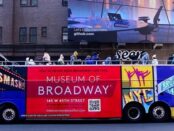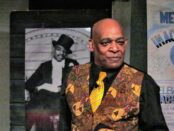The Wiz
The eye-filling sets by Hannah Beachler and video and projection design by Daniel Brodie include subtle tributes to Black Culture that not all theatergoers may notice on a first look. When Dorothy first lands in Oz, the landscape and houses are reminiscent of Tremé, the Black neighborhood in New Orleans decimated by Hurricane Katrina. The overhead set piece is inspired by the arch in New Orleans’ Louis Armstrong Park as well as incorporating patterns found in quilts on the Underground Railroad. African symbols are carved into the bark of the trees along Dorothy’s path on the Yellow Brick Road as well as depicted on the sides of the theater proscenium arch. When Glinda enters, she comes out of house at the address 1804, commemorating the year of Haiti’s independence. The red and black sets and costumes (by Sharon Davis) for the sequence in the Castle of Evilene are a tribute to West African culture. [more]



